Excerpts from Jim Conrad's
Naturalist Newsletter
from the February 12, 2017 Newsletter issued from Rancho Regenesis in the woods ±4kms west of Ek Balam Ruins; elevation ~40m (~130 ft), N20.876°, W88.170°; north-central Yucatán, MÉXICO
PINEAPPLES FLOWERING
Here at the rancho anytime someone buys a pineapple the tufted top is cut off and planted in the ground. Before long roots form and the tuft starts growing, eventually producing knee-high rosettes of stiff, yellowish-green blades reddish-tented at their tips, such as those shown below:
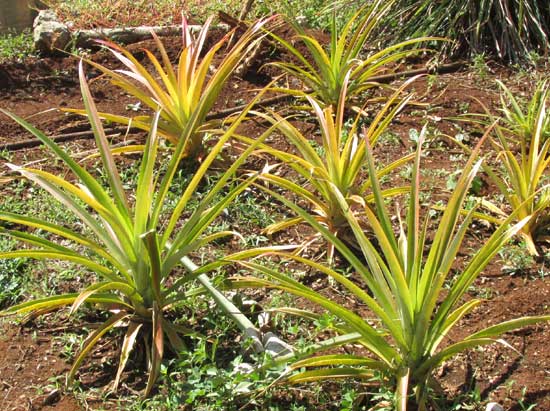
The plants in the picture haven't begun producing pineapples yet. A view into one of the plant's center showing nothing but a clutter of dried-up leaves where the future pineapple fruit will set is shown below:

Nowadays a few of our pineapple plants have their rosette centers occupied by apple-sized flowering heads perched atop thick, finger-long peduncles, like the one shown below:
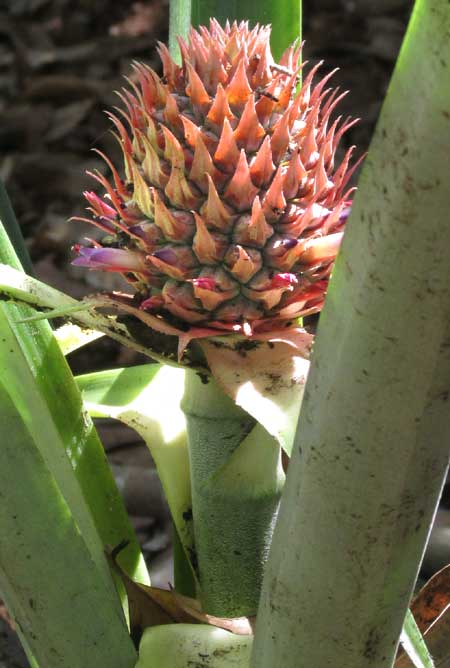
In that picture, notice the violet-hued flower at the head's lower, left. The flower itself has no stem, or pedicel. The pinkish, triangular items bristling all around are spiny-toothed bracts, bracts being leaves modified to fulfill some purpose. In the pineapple's flowering head the purpose appears to be to dissuade herbivores from nibbling on the flowers and future fruit. A close-up showing a pineapple flower's cylinder-like corolla with three stuck-together petals is shown below:
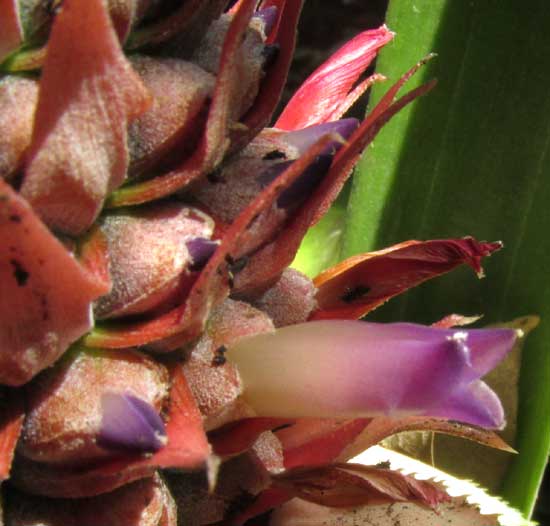
The Maya workers tell me that in a couple of months we'll have pineapples to eat. It'll be interesting to watch how the flowering heads develop into syrupy pineapple fruit.
from the June 7, 2018 Newsletter issued from Rancho Regenesis in the woods ±4kms west of Ek Balam Ruins; elevation ~40m (~130 ft), N~20.876°, W~88.170°; central Yucatán, MÉXICO
PINEAPPLES WITH RIPE FRUIT
Nowadays in my garden the plants are producing fruits so large and heavy that the fruits are falling over, as shown below:
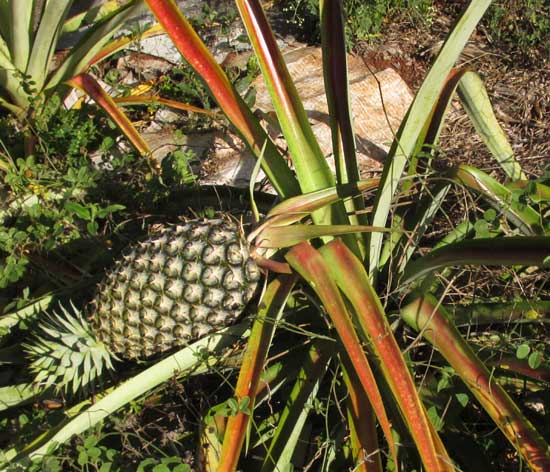
As the pineapple grew larger, the plant's blades began turning red, withering and drying up, apparently transferring nutrients into the fruit.
from the June 21, 2018 Newsletter issued from Rancho Regenesis in the woods ±4kms west of Ek Balam Ruins; elevation ~40m (~130 ft), N~20.876°, W~88.170°; central Yucatán, MÉXICO
EATING PINEAPPLE
This week when I harvested one of our fruits I cut it open lengthwise instead of across, so that a better view of its internal anatomy can be seen. Below, you can see the fruit, the deep pit beside the hut serving as a dark background:
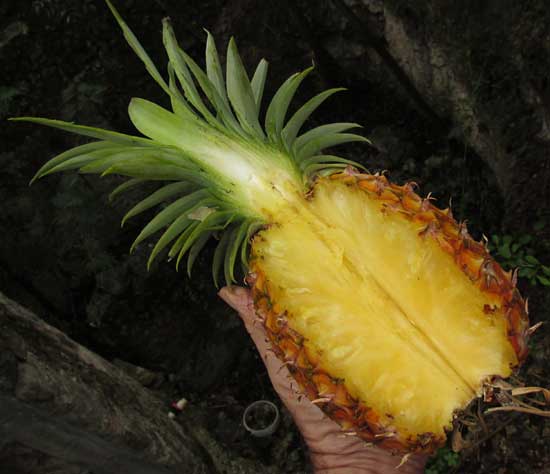
Notice how the tuft of leaves at the top arises from a solid, whitish zone. In fact, that firm, solid tissue, becoming softer, yellow and sweet, continues all the way through the pineapple fruit, then hardening again and continuing into the fruit's stalk when it was present. This solid core of leaves, fruit and stalk can be visualized as an axis that continues from generation to generation, for the pineapple's top can be cut off, the tuft of leaves will root, and eventually a new pineapple will appear in the tuft's center. This perpetually extending "axis" can be seen in our earlier picture of an immature, flowering pineapple atop its stout stalk shown at www.backyardnature.net/n/17/170212pc.jpg
A close look at the pineapple fruit's interesting surface is shown below:
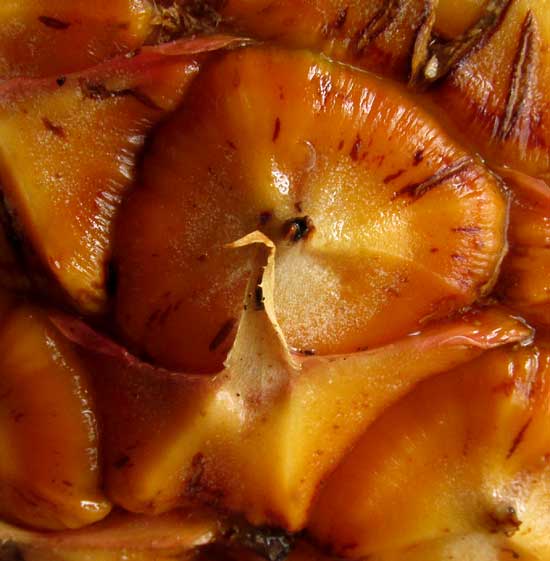
To help make sense of what's being seen there, it might help to know that in the old days pineapple plants, Ananas comosus, were assigned to the genus Bromelia. In our area we have two commonly occurring Bromelia species, and of course they are very closely related to pineapple plants, and share basic anatomy. Take a look at the flower cluster, or inflorescence, of our local Bromelia pinguin.
There we see individual flowers held in a somewhat loose cluster, atop a strong stalk (axis). Anatomically, this is just like we've seen with the pineapple, except that on pineapple plants the flowers are all crammed together into a cone-like unit with the axis inside. A few weeks earlier, that loose cluster of Bromelia pinguin flowers started out with the flowers held close together, shown at www.backyardnature.net/18/180311bc.jpg
In that picture, notice that each flower has at its base a pale, sharp-pointed scale, or "bract," a bract being a modified leaf.
Therefore, in our close-up picture of a pineapple fruit's surface, the roundish item occupying most of the picture's middle, with a dark spot in its center, is the mature ovary of an earlier flower. The broad, scoop-like thing below the mature ovary, looking like an orange pterodactyl with a sharp head, is what's become of the flower's bract. Since usually we think of a flower's matured ovary as a fruit, this means that the pineapple "fruit" is actually composed of many fused-together "fruits." Pineapple fruits are "multiple fruits," like figs, mulberries and Osage Oranges. There's a nice diagram making all this clearer on our Multiple Fruit page at www.backyardnature.net/frt_mult.htm
Once all this has sunk in, it's more fun to look closely into the pineapple's yellow interior, shown below:
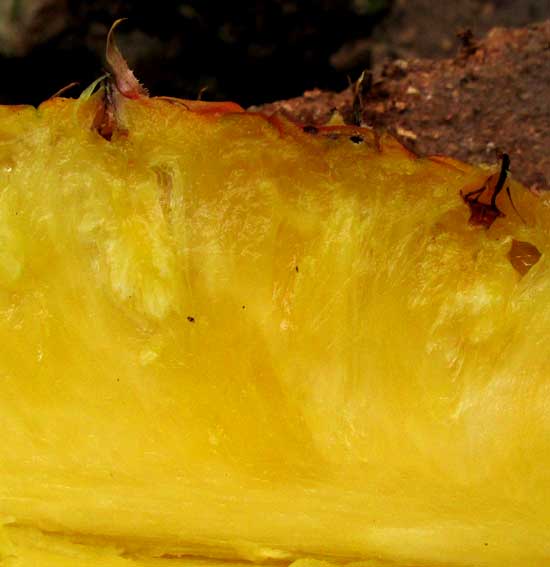
At the picture's bottom it's solid and firm, and away from this core/axis the pineapple's flesh becomes markedly softer. Near the fruit's surface at the picture's top the flesh looks soft, juicy, and is interrupted here and there by crater-like pits and other openings. A close-up a pit is shown below:
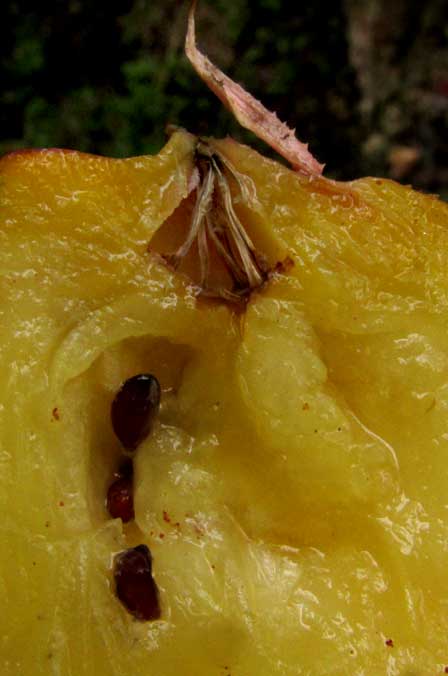
The purplish, sharp-tipped thing at the picture's top is the bract tip, and you can see that as soon as the bract reaches the pineapple's surface it grows thick and juicy, and becomes as edible as all the rest. Inside the crater below the bract we see dried remains of the flower's stamens. The ovary below the stamens has grown up over this part of the old flower.
But, the surprising feature of this picture is that below the stamens, embedded in the ovary's flesh, there's an open chamber containing three dark, shiny seeds. Commercially produced pineapples very seldom produce seeds, because growers use cultivars that don't develop them, pineapples with seeds being deemed less desirable.
I'm unsure why this pineapple had seeds. It may be a cultivar of the past before people started growing strictly seedless ones, or it may be because when I started gardening in this spot several pineapple plants had been planted there for three or four years without fruiting. In well managed pineapple plantations fruits can be produced in a year or two, but they need more time under less than ideal conditions. Maybe our plant's stress had caused them to produce seeds.